http://www.nytimes.com/2014/12/05/world/middleeast/examining-a-rare-nerve-agent-shell-that-wounded-american-troops-in-iraq.html DEC. 4, 2014 Examining a Rare Nerve-Agent Shell That Wounded American Troops in Iraq By C. J. CHIVERS and JOHN ISMAY The attack began like many others. Early on May 15, 2004, an American patrol was sweeping a highway in Baghdad, trying to clear the route for a convoy. An attacker in hiding, watching a spot where a roadside bomb had been hidden, detonated the bomb as the patrol neared the anticipated kill zone. There was a small blast, but something was clearly different from the typical explosions that accompanied roadside bombs. Although the soldiers did not yet know it, they had just been attacked by a previously unseen type of makeshift bomb: a device made from an artillery shell designed to disperse a nerve agent. The resulting release of sarin, which several munitions analysts describe as the first case in history of a nerve agent being used in an improvised explosive device, eventually wounded two American explosive ordnance disposal technicians, Staff Sgt. James F. Burns and Pfc. Michael S. Yandell, who shared their account of the attack in a recent report in The New York Times. [1] After that report, another veteran of the Iraq war came forward with a set of photographs of the Army's initial examination and liquid sampling of the sarin shell. The veteran asked not to be identified, and said he had not taken the photographs. But he gave permission to publish the images, to add detail to the study of chemical warfare programs and munitions, and to allow open-source analysts to view one of the most unusual weapons seen during the American occupation of Iraq. Background: A Binary Sarin Shell as a Makeshift Bomb It is important to note that for all of the emotional and political energy that attaches to chemical weapons and their use, this bomb was only marginally effective. The shell was not fired as it was designed to be, and it did not disperse a nerve agent over a wide area. It killed no one. According to the available accounts, it wounded only the two people who handled it without wearing protective clothing and masks. The highway quickly reopened. The war went on as before. For a so-called weapon of mass destruction, the damage was limited. This is not to minimize the seriousness of sarin's effects on Sergeant Burns and Private Yandell. [2] Those effects were striking and pernicious: Sergeant Burns, now retired, reported a lingering cluster of neurological complaints, [3] including problems with memory, dexterity and balance. But the bomb, as it was constructed and used, did not prove to be a grave menace. Had the bomb maker used a conventional high-explosive shell instead of the sarin round, the device might have done more harm. Many of the ordnance technicians who have reviewed the attack say they suspect that the bomb maker who fielded the weapon, using a shell from the 1980s, was not even aware that the shell was a chemical round, and that if he was aware, he did not know how to maximize its potential sarin dispersal. It is also worth noting that even if the bomb maker knew what he had, an improvised explosive device containing a nerve agent would not have been a new concept. It would have been a low-tech echo of a far more efficient design worked out in the United States during the Cold War. In the 1950s, the United States developed the M23 land mine, which contained roughly 10 pounds of the V.X. nerve agent. And in the 1960s, a laboratory affiliated with Cornell University proposed a pop-up adapter [4] for the M23 mine that would launch a V.X. canister as high as 65 feet in the air, where it would burst and disperse the nerve agent as an aerosol. The laboratory's report noted that this bounding, air-bursting package of V.X. could be actuated "by booby-trap devices." So the sarin improvised explosive device in Iraq was a comparatively weak version of a weapon that Western arms designers contemplated decades ago. Back to the moment after the attack: Thinking they had been targeted by a conventional bomb that had not functioned properly, the soldiers on the highway called for an ordnance disposal team to clean up the scene and remove the bomb's debris. Sergeant Burns and Private Yandell arrived to find the shell lying on the asphalt, its nose open and cracked. The technicians mistook it for a conventional shell and carried it back to their truck for destruction later in a safer place. At that point, Sergeant Burns and Private Yandell did not realize the risk. According to a later report by the Iraq Survey Group, a task force established by the C.I.A. after the American-led invasion, the two soldiers were transporting one of Iraq's rarest weapons: a prototype 152-millimeter binary sarin shell, a limited-production experimental item from the 1980s, which was now leaking sarin in their truck. It was at this point -- in the confines of a vehicle, with the technicians sitting on the front seats and the shell in the back -- that the shell became much more dangerous. Binary chemical shells work by a simple principle. Rather than have an active chemical agent in a reservoir within the weapon, two precursor chemicals are stored in separate canisters that are designed to rupture as the shell is fired. The chemicals are then mixed by the shell's rotation in flight, creating freshly brewed agent. In theory, such designs make weapons safer (because leaks are less likely, and less likely to be lethal) and potentially more reliable (because, in this case, Iraq's sarin was unstable and prone to swift degradation in storage). How many of the 152-millimeter binary shells existed in Iraq's inventory is an unsettled question. In its confidential declaration to the United Nations [5] in 1996, Iraq claimed to have experimented with adapting 152-millimeter propaganda shells (used for distributing leaflets) to hold aluminum, and possibly plastic, canisters of sarin precursors instead. The declarations said that as many as 27 of these special shells had been expended in firing tests. Another quantity of the shells -- a later C.I.A. document [6] suggested a handful to as many as 40 -- may have been stored for a long-term leak test at a laboratory at Al Muthanna State Establishment, [7] the former center of Iraq's chemical warfare agent production. Between Iraq's secrecy and the small quantity of shells involved, this model of shell was quite rare, and almost completely unpublicized. Jack McGeorge, a munitions analyst for the United Nations Monitoring, Verification and Inspection Commission, the group monitoring Iraq's arsenal, did manage to include an image of what he believed to be one of the shells in the Chemical and Biological Munitions and Related Material Recognition Handbook, a confidential United Nations field guide to Iraq's unconventional munitions. An excerpt from that book is below. Iraq's Rarest Weapon An excerpt of the confidential field guide to Iraq's unconventional munitions produced by the United Nations showed what it believed was a rare prototype 152-millimeter binary sarin shell.
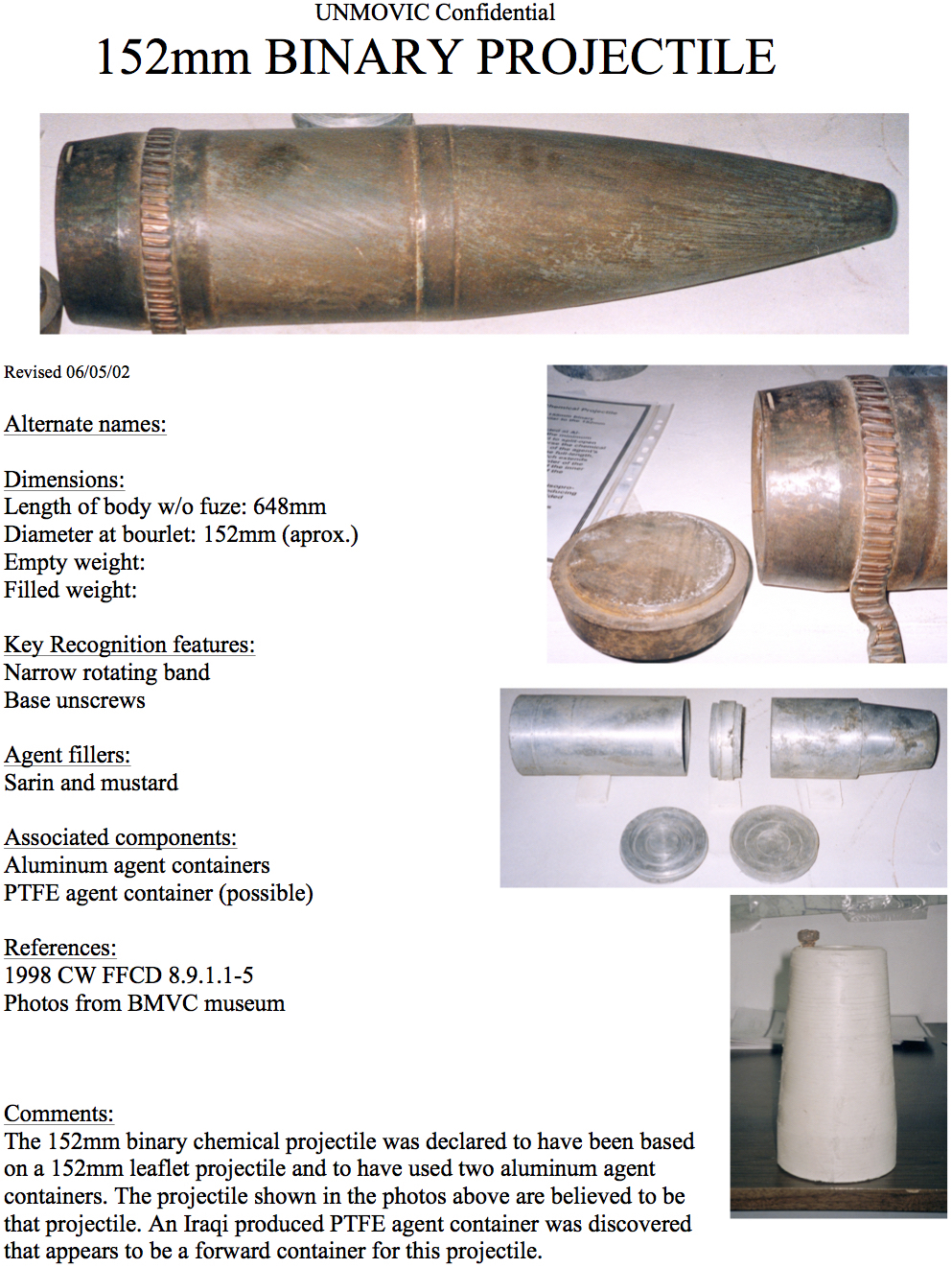 The rarity of the display above is important in understanding how the shell ended up in the technicians' truck. There was very little published record of these shells for ordnance disposal teams to refer to in the field. When Sergeant Burns and Private Yandell encountered the shell, it was not in the standard American guidebooks used to identify munitions loose in Iraq. This, to some degree, explains why they misidentified it and put it in their truck without sealing it in plastic, which would have prevented its sarin vapors from filling the enclosed space around them.
Instead, the soldiers became ill as they drove. Upon arriving at their base, Camp Ferrin-Huggins in Baghdad, the technicians were suffering the effects of nerve-agent exposure, including confusion, pinpointed pupils, labored breathing and headaches. Soon they were in a clinic, and their treatment and monitoring began.
From this point, the record picks up a visual component, and we can refer to a photograph that accompanied the main Times article and shows the same shell wrapped in plastic on the tailgate of a military truck. The process of wrapping, shown below, is known as a leak-seal and package. It signified a shift in the incident from a routine explosive ordnance disposal call to a chemical-warfare response.
The rarity of the display above is important in understanding how the shell ended up in the technicians' truck. There was very little published record of these shells for ordnance disposal teams to refer to in the field. When Sergeant Burns and Private Yandell encountered the shell, it was not in the standard American guidebooks used to identify munitions loose in Iraq. This, to some degree, explains why they misidentified it and put it in their truck without sealing it in plastic, which would have prevented its sarin vapors from filling the enclosed space around them.
Instead, the soldiers became ill as they drove. Upon arriving at their base, Camp Ferrin-Huggins in Baghdad, the technicians were suffering the effects of nerve-agent exposure, including confusion, pinpointed pupils, labored breathing and headaches. Soon they were in a clinic, and their treatment and monitoring began.
From this point, the record picks up a visual component, and we can refer to a photograph that accompanied the main Times article and shows the same shell wrapped in plastic on the tailgate of a military truck. The process of wrapping, shown below, is known as a leak-seal and package. It signified a shift in the incident from a routine explosive ordnance disposal call to a chemical-warfare response.
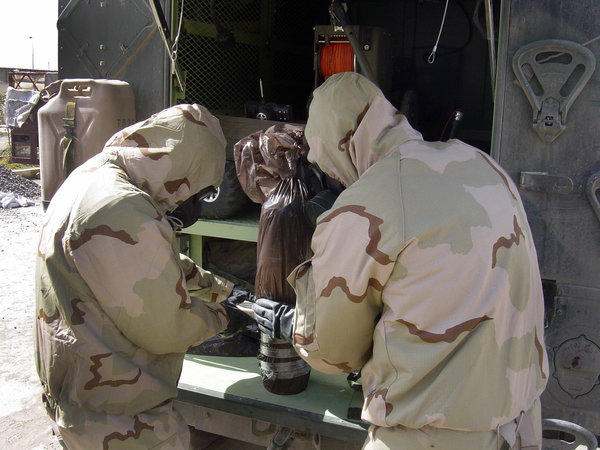
Credit Christopher Jewett/United States Navy A Navy explosive ordnance disposal team in 2004, sealing the sarin shell that had wounded Sergeant Burns and Private Yandell. Temporary sealing was meant to contain the remaining sarin residue in the shell. It was being performed by a Navy explosive ordnance disposal team, which bunked with Sergeant Burns's team in 2004. That Navy team soon passed custody of the round to a small group of Army chemical warfare specialists, known as a technical escort unit. The soldiers seen in the images that pick up from here, which show a team reopening the packaging and obtaining sarin samples, appear to be from that unit.

The New York Times A soldier with a warfare-agent detector prepared to cut open the plastic wrap. The Times shared copies of these photographs with the Army to check their veracity. In an email reply, Brig. Gen. J. B. Burton, commanding general of the 20th Chemical, Biological, Radiological, Nuclear, Explosives Command, the Army's primary unit to counter weapons of mass destruction, said the team was "following standard procedures for sampling, sealing/wrapping, protection, decontamination and detection" of a chemical warfare shell. By the time the first layer of outer wrapping had been removed, above, the screen on the warfare-agent detector had begun indicating the presence of a nerve agent.

The New York Times The Navy team had sealed the shell's nose with a cloth plug; apparent traces of sarin had spilled down the shell's side. Fully removing the plastic wrap revealed that the Navy team had closed the shell's nose with duct tape over a cloth plug, which the soldiers removed. At this point, the risks were rising, and several ordnance disposal technicians who reviewed these photographs for The Times had misgivings about what the photographs show. Why, they asked, was the team unsealing the shell on an occupied American base, squarely beside a work space? The safer alternative would be to move the shell to a remote location or a demolition range, and to seek a sample there. General Burton said the reasons for unsealing the round were not clear. "We are uncertain why this procedure was done in close proximity to living space or occupied buildings," he wrote.
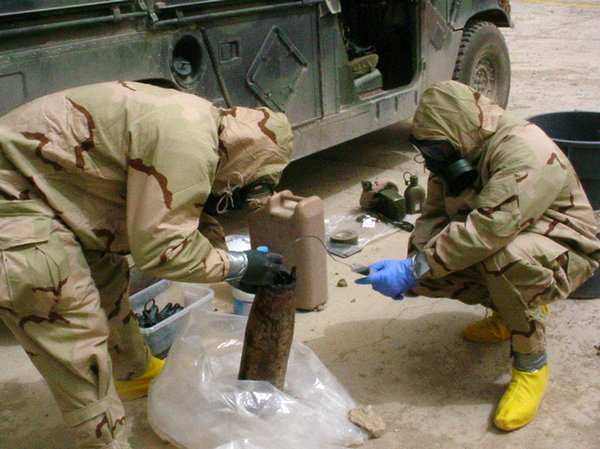
The New York Times Soldiers siphoned sarin from the shell. Next, the soldiers extracted samples of the liquid in the shell, siphoning it out with a small syringe pump and tube. The photograph shows a stream of dark liquid as it is drawn out, and although references describe sarin as colorless, the darkness is not surprising. The shell, at the former fuze well at its nose, shows signs of internal burning, perhaps from the effect of a blasting cap on the canisters inside as the shell was fired as an improvised explosive device. Judging by how one soldier tilts the shell in the image at right, the shell was not full. (This aligns with Sergeant Burns's memories of the shell on the road. It was not full when they first saw it, though it did leak a small puddle in the back of his truck, he said.)
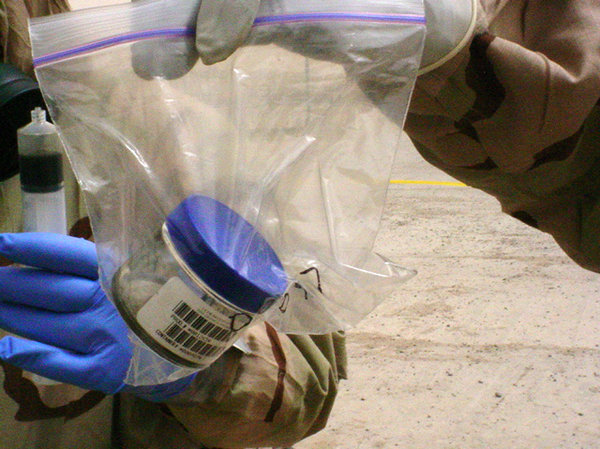
The New York Times Although sarin is described as colorless, a dark liquid was extracted, revealing signs of internal burning. The soldiers then transferred the liquid into a specimen cup, and sealed the cup in a plastic bag. Judging from the many photographs The Times received, the team took several samples for lab work later. Various sources have indicated that the nerve-agent sample from the shell tested at 43 percent purity. The C.I.A. document mentioned above described the shell as "containing a 40 percent concentration of sarin." Either figure suggests that the two precursor chemicals were in reasonably good shape, and that even with the imperfect mixing that would occur in an improvised explosive device blast, a quantity of dangerous sarin was produced inside a prototype shell that would have been, if Iraq's declarations to the United Nations were accurate, roughly 16 years old. Chemical Weapons Found by American Forces in Iraq Between 2004 and 2010, American forces in Iraq encountered thousands of chemical munitions. In several cases, troops were exposed to chemical agents.
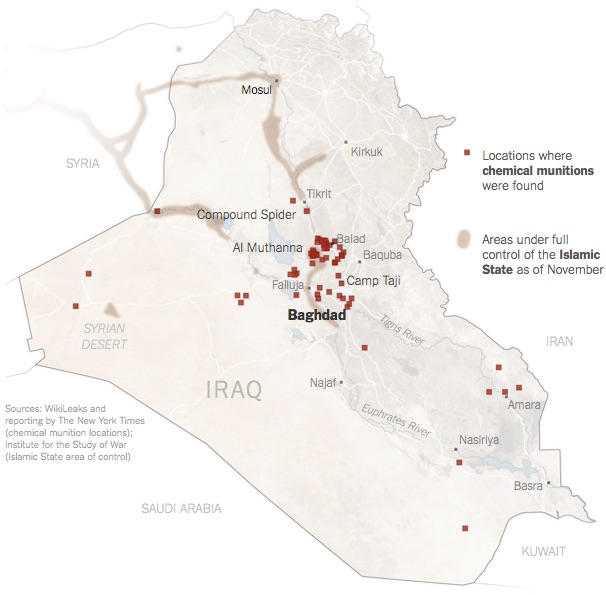
 [1] http://www.nytimes.com/interactive/2014/10/14/world/middleeast/us-casualties-of-iraq-chemical-weapons.html
[2] http://www.nytimes.com/interactive/2014/10/14/world/middleeast/iraq-chemical-weapons-medical-records.html#document/p13/a182277
[3] http://www.nytimes.com/interactive/2014/10/14/world/middleeast/iraq-chemical-weapons-medical-records.html#document/p11/a182276
[4] http://www.dtic.mil/dtic/tr/fulltext/u2/b217519.pdf
[5] http://www.nytimes.com/interactive/2014/10/14/world/middleeast/iraqs-disclosure-of-chemical-weapons-findings-to-un.html#document/p301/a189176
[6] https://www.cia.gov/library/reports/general-reports-1/iraq_wmd_2004/chap5_annxF.html
[7] http://www.nytimes.com/interactive/2014/10/14/world/middleeast/duelfer-report-on-chemical-weapons-in-iraq.html#document/p12/a179495
[1] http://www.nytimes.com/interactive/2014/10/14/world/middleeast/us-casualties-of-iraq-chemical-weapons.html
[2] http://www.nytimes.com/interactive/2014/10/14/world/middleeast/iraq-chemical-weapons-medical-records.html#document/p13/a182277
[3] http://www.nytimes.com/interactive/2014/10/14/world/middleeast/iraq-chemical-weapons-medical-records.html#document/p11/a182276
[4] http://www.dtic.mil/dtic/tr/fulltext/u2/b217519.pdf
[5] http://www.nytimes.com/interactive/2014/10/14/world/middleeast/iraqs-disclosure-of-chemical-weapons-findings-to-un.html#document/p301/a189176
[6] https://www.cia.gov/library/reports/general-reports-1/iraq_wmd_2004/chap5_annxF.html
[7] http://www.nytimes.com/interactive/2014/10/14/world/middleeast/duelfer-report-on-chemical-weapons-in-iraq.html#document/p12/a179495